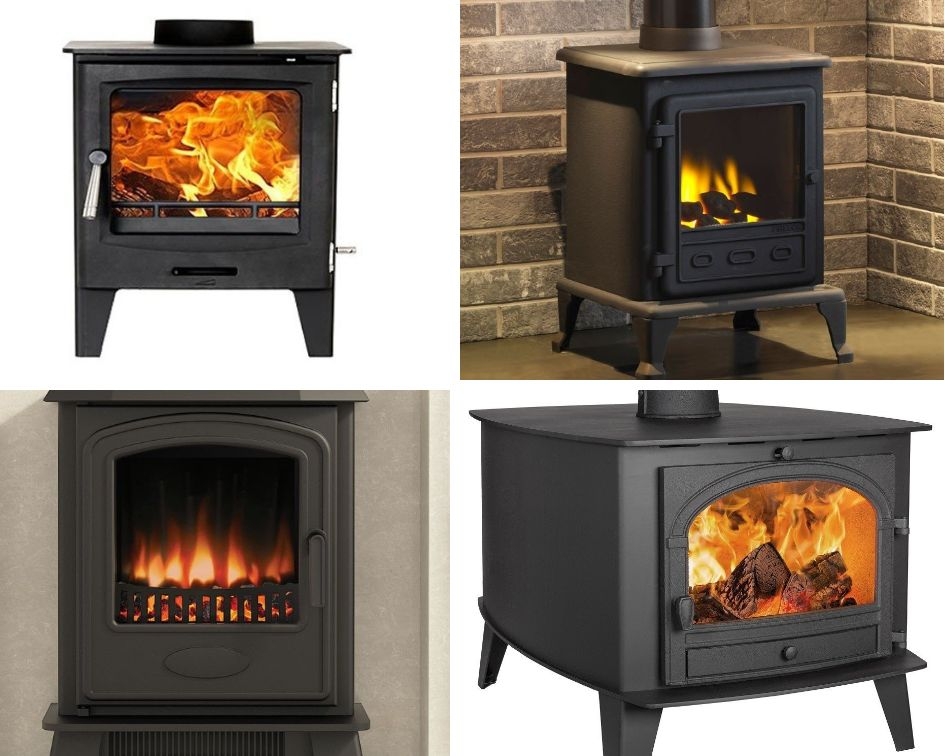A Guide to the Different Types of Stoves

In the UK we have a long tradition of using stoves for heating our homes, and nowadays, they are regaining popularity. People have always loved the warm look fire brings to a room. However, an open fireplace can be messy to clean and also dangerous if not constantly watched, and with our modern-day lifestyles, this is not practical. On the other hand, a stove still gives your home the warm glow of flames but can be safely left unattended for extended periods.
There are many diverse types and styles of stoves on the market today. You can choose from free-standing models or stove inserts. There are wood-burning or multi-fuel stoves, gas burners, or electric versions to choose from. You've also got the option of going for a boiler stove that will heat the room and a hot water or radiator system. There are double-sided stoves that allow you to see the flames from both sides. Or you can place a double-sided stove in a gap made in a wall, enabling you to heat two rooms with one appliance. Then there are cooker stoves, modern versions of the old-fashioned kitchen ranges, outdoor stoves, and even sauna stoves.
A free-standing stove is a traditional and popular method used for heating British homes. These can be placed in an existing fireplace or anywhere in the room as long as there is an outside wall where the flue pipe can release the smoke. In general, these are termed wood burners, but as most wood-burning stoves are made of dense cast iron, consumers can use them for other manufactured solid fuels. Rolled steel is another suitable material often used to make these stoves, which can burn wood, solid biomass fuel, and briquettes. Some attractive gas stoves are available, and all stove types safely and rapidly heat a room.
Stove inserts are designed to be built into either a wall or an existing fireplace. With a stove insert, the heat only radiates out from the front, so most models have an airflow system that directs the heat from the back of the stove out into the room. If you only want an attractive feature and do not intend to take full advantage of the heat output wood-burning or multi-fuel stoves provide, then an electric insert stove is a good-looking, clean option.
Boiler stoves are designed to use a major part of the fire's heat as energy for a hot water system. A boiler stove can be used solely for household hot water or to heat several radiators. Either free-standing or inserts, these stoves are the most efficient in using all the energy produced by burning the fuel used.
Whichever type of stove you consider most practical or whichever kind of fuel you wish to use; you will find a fabulous choice of distinctive designs. The right stove will make a very eye-catching focus in any room, and with so many to choose from, you will have no problem finding a style that you like.
DEFRA Approved Stoves
A DEFRA Smoke Exempt Appliance is a wood-burning that passes the UK Government's Department of Environment, Farming and Rural Affairs standards for pollution levels and the volume of smoke it produces. It is always best to buy a stove approved by DEFRA.
Most DEFRA Approved stoves are modified by manufacturers to limit the pollution they emit by 'closing down'. They can be starved of air, preventing them from creating too much smoke. A DEFRA Approved stove uses the minimum level of combustion air so that fuel burns efficiently without generating unnecessary smoke, thus guaranteeing the appliance adheres to the Clean Air Act. You can use a DEFRA Approved wood stove legally in a Smoke Control Area – which includes most of the UK's large towns.
Permitted Stove Fuels
Under a government ban that became law on May 1st, 2021, it is illegal for owners of wood burners, stoves, and fireplaces to burn the most polluting fuels.
It does not ban wood-burning stoves, just the two most polluting fuels that were previously popular choices.
Coal is a fossil fuel that releases copious quantities of carbon dioxide and particulates that pollute the air and is now banned.
Wood is considered a carbon-neutral fuel because we can replace felled trees. However, wet wood holds moisture, which produces more smoke and harmful particles into the atmosphere than adequately dry wood. Furthermore, wet wood can also damage the flue and chimney.
Dry wood with a moisture content of less than 20% is permitted. Dry wood creates less smoke than wet wood. To be considered dry, wood must be seasoned, a process that removes moisture.
You can season wood by stacking it in a covered area in a way that allows air to circulate around the wood, removing moisture as it evaporates. This process takes a minimum of one year, and ideally, two should be allowed.
Solid fuels which deliver low pollution are permitted to burn in England since the change of law. Solid fuels include wood briquettes, sawdust, and wood chips. Approved solid fuels must have an extremely low sulphur content and only transmit a small volume of smoke.
Stove Installation
A gas stove should be correctly installed by a GasSafe registered installer, while a solid fuel burner stove is best put in by a HETAS registered installer.
If you are unsure about which type of stove to buy or the installation of the stove, don't hesitate to contact us. Our stove experts are always happy to answer your questions.


